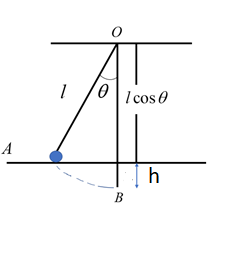Question
Question: A suspended simple pendulum of length \(l\) is making an angle \(\theta \)with the vertical. On rele...
A suspended simple pendulum of length l is making an angle θwith the vertical. On releasing, its velocity at the lowest points will be,
2gl(1+cosθ)
2glsinθ
2gl(1−cosθ)
2gl
Solution
The mass is attached to an inextensible string and suspended from the fixed support. It is called a simple pendulum. To solve the given problem, consider the positions of the pendulum that is held.
Formula used:
⇒21mv2=mgh
Where,
mis the mass,v is the velocity, g is the acceleration, and h is the height
Complete step by step answer:

OAis given as l. Where lis the length of the pendulum. OB is given as lcosθ. In the given diagram the length lis making an angle θ with the vertical.
Calculate the height of the pendulum. We can consider OA and OB
⇒OB=OAcosθ
OAis given as l. Substitute the OAvalue in the equation.
⇒OB=lcosθ
The height of the pendulum can be calculated as,
⇒h=OA−OB
Substituting the values of the OA and OBwe get,
⇒h=l−lcosθ
Take out l as the common.
⇒h=l(1−cosθ)
Therefore the height of the pendulum is l(1−cosθ).
The velocity of the pendulum released at the lowest point means the velocity of the pendulum when released from OA to OB. To calculate the velocity consider the energies at the Aand B.
Consider kinetic energy at Aand the potential energy at B.
Kinetic energy at Ais equal to the potential energy at B
⇒21mv2=mgh
Where,
mis the mass, v is the velocity, g is the acceleration, and h is the height
Cancel out the common terms in the equation.
⇒21v2=gh
Taking the left-hand side 2 from the denominator to the right-hand side numerator,
⇒v2=2gh
Substitute the value of the height in the equation.
⇒v2=2gl(1−cosθ)
To remove the square on the left-hand side, take the square root on the right-hand side. We get,
⇒v=2gl(1−cosθ)
Therefore, the value of the simple pendulum on releasing, its velocity at the lowest points will be,
⇒v=2gl(1−cosθ)
So, the correct answer is “Option C”.
Note:
The pendulum will have one mean position and two extreme positions. At the mean position, the energy of the pendulum is kinetic. At the two extreme positions, the energy of the pendulum is potential. And in between the extreme and mean position the energy is potential plus kinetic.
